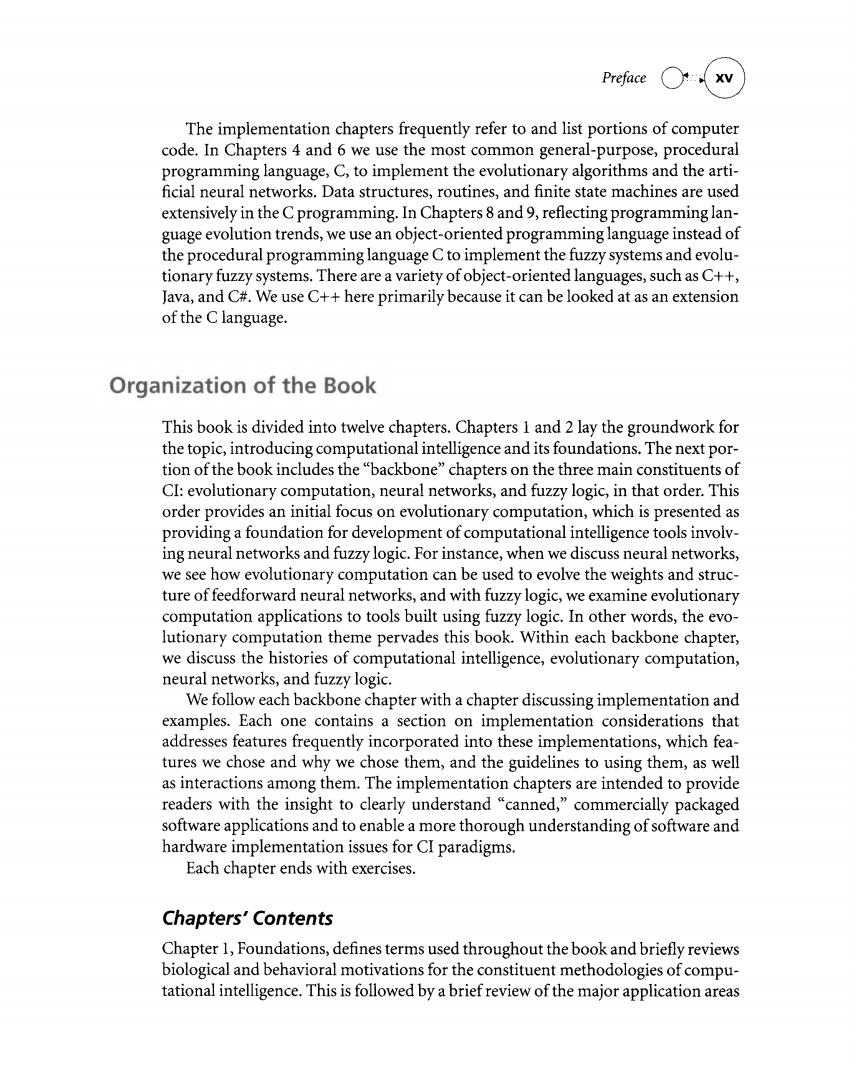正在加载图片...

Preface The implementation chapters frequently refer to and list portions of computer code.In Chapters 4 and 6 we use the most common general-purpose,procedural programming language,C,to implement the evolutionary algorithms and the arti- ficial neural networks.Data structures,routines,and finite state machines are used extensively in the C programming.In Chapters 8 and 9,reflecting programming lan- guage evolution trends,we use an object-oriented programming language instead of the procedural programming language C to implement the fuzzy systems and evolu- tionary fuzzy systems.There are a variety of object-oriented languages,such as C++, Java,and C#.We use C++here primarily because it can be looked at as an extension of the C language. Organization of the Book This book is divided into twelve chapters.Chapters 1 and 2 lay the groundwork for the topic,introducing computational intelligence and its foundations.The next por- tion of the book includes the "backbone"chapters on the three main constituents of CI:evolutionary computation,neural networks,and fuzzy logic,in that order.This order provides an initial focus on evolutionary computation,which is presented as providing a foundation for development of computational intelligence tools involv- ing neural networks and fuzzy logic.For instance,when we discuss neural networks, we see how evolutionary computation can be used to evolve the weights and struc- ture of feedforward neural networks,and with fuzzy logic,we examine evolutionary computation applications to tools built using fuzzy logic.In other words,the evo- lutionary computation theme pervades this book.Within each backbone chapter, we discuss the histories of computational intelligence,evolutionary computation, neural networks,and fuzzy logic. We follow each backbone chapter with a chapter discussing implementation and examples.Each one contains a section on implementation considerations that addresses features frequently incorporated into these implementations,which fea- tures we chose and why we chose them,and the guidelines to using them,as well as interactions among them.The implementation chapters are intended to provide readers with the insight to clearly understand "canned,"commercially packaged software applications and to enable a more thorough understanding of software and hardware implementation issues for CI paradigms. Each chapter ends with exercises. Chapters'Contents Chapter 1,Foundations,defines terms used throughout the book and briefly reviews biological and behavioral motivations for the constituent methodologies of compu- tational intelligence.This is followed by a brief review of the major application areasPreface ~."~ The implementation chapters frequently refer to and list portions of computer code. In Chapters 4 and 6 we use the most common general-purpose, procedural programming language, C, to implement the evolutionary algorithms and the artificial neural networks. Data structures, routines, and finite state machines are used extensively in the C programming. In Chapters 8 and 9, reflecting programming language evolution trends, we use an object-oriented programming language instead of the procedural programming language C to implement the fuzzy systems and evolutionary fuzzy systems. There are a variety of object-oriented languages, such as C++, Java, and C#. We use C++ here primarily because it can be looked at as an extension of the C language. Organization of the Book This book is divided into twelve chapters. Chapters 1 and 2 lay the groundwork for the topic, introducing computational intelligence and its foundations. The next portion of the book includes the "backbone" chapters on the three main constituents of CI: evolutionary computation, neural networks, and fuzzy logic, in that order. This order provides an initial focus on evolutionary computation, which is presented as providing a foundation for development of computational intelligence tools involving neural networks and fuzzy logic. For instance, when we discuss neural networks, we see how evolutionary computation can be used to evolve the weights and structure of feedforward neural networks, and with fuzzy logic, we examine evolutionary computation applications to tools built using fuzzy logic. In other words, the evolutionary computation theme pervades this book. Within each backbone chapter, we discuss the histories of computational intelligence, evolutionary computation, neural networks, and fuzzy logic. We follow each backbone chapter with a chapter discussing implementation and examples. Each one contains a section on implementation considerations that addresses features frequently incorporated into these implementations, which features we chose and why we chose them, and the guidelines to using them, as well as interactions among them. The implementation chapters are intended to provide readers with the insight to clearly understand "canned," commercially packaged software applications and to enable a more thorough understanding of software and hardware implementation issues for CI paradigms. Each chapter ends with exercises. Chapters" Contents Chapter 1, Foundations, defines terms used throughout the book and briefly reviews biological and behavioral motivations for the constituent methodologies of computational intelligence. This is followed by a brief review of the major application areas